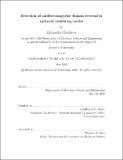Detection of antiferromagnetic domain reversal in epitaxial insulating oxides
Author(s)
Churikova, Alexandra
DownloadThesis PDF (10.70Mb)
Advisor
Beach, Geoffrey S.D.
Terms of use
Metadata
Show full item recordAbstract
Antiferromagnetic materials have historically played a passive role as biasing layers in spintronics applications due to the challenges in manipulating and detecting the magnetic order. However, substituting ferromagnets by antiferromagnets as active switching elements in data storage devices offers the potential for ultrafast dynamics, improved non-volatility, higher bit packing density, and qualitatively new physical phenomena. These advantages spurred intensive research in current-induced switching of the magnetic order in metallic and insulating antiferromagnets. Insulating antiferromagnetic insulators are promising due to their magnon-mediated long-distance spin transport, THz response, and rich platforms for fundamental study.
Here, we approach the challenge of manipulating antiferromagnetic order in insulating oxides. First, we demonstrate the limitation of purely electrical detection of switching of the antiferromagnetic order with spin-orbit torques from electric current pulses. In epitaxial nickel oxide thin-films interfaced with a heavy metal as a source of spin-orbit torque, we show that electrical signatures that have previously been attributed to magnetic switching arise from localized thermo-resistive heating and electromigration in the heavy metal. Secondly, we exploit the weak ferromagnetic nature of epitaxial hematite thin-films to directly control the antiferromagnetic sublattices with current pulses. To achieve this, we experimentally elucidate the magnetoelastic relaxation mechanism that governs magnetic field-driven antiferromagnetic domain reversal. This approach, with our analytical model for the field-induced response, reveals the role of the film magnetostriction and anisotropy. With this novel framework, we demonstrate deterministic current-driven control of the antiferromagnetic order which we show is driven by predominantly thermo-magnetoelastic torques. This work provides fundamental insight into physical phenomena governing domain reversal, crucial to realizing antiferromagnets as active spintronics device elements.
Date issued
2022-05Department
Massachusetts Institute of Technology. Department of Materials Science and EngineeringPublisher
Massachusetts Institute of Technology